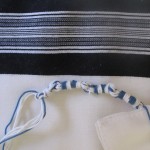Although I encourage my customers to try tying tzitzit themselves, most of them are not ready to take the plunge, and so we tie the tzitzit for at least 90% of the orders we receive. But this week we received a detailed inquiry from someone by the name of Bennett who wants to tie techelet according to the Vilna Gaon, and sent me a number of good questions.
G-d willing, I will be placing an order for a tallit in the very near future. I would also like to tie my own tzitzit, which I see to request that in the comments when purchasing. My question is actually about the tying method.
I am of Ashkenazim heritage and have resolved myself to the Vilna Gaon method. It is the one that my eye seems to gravitate to the most and without any other rationale, it seems like a good one.
I’ve found several good resources through your site and tekhelet.com but I’m afraid I’m still unsure about a couple of things.

Vilna Gaon is quite straightforward. Basically you can just watch one of the online videos for regular white tzitzit, and then all you have to add on is switching back and forth from white shamash to blue shamash.
* Is the blue string considered the shamesh? In a set of Raavad tzitzit you’ll find eight regular strings, four blue strings and four long white strings. So for every corner you take two white, one long white and the blue, even them on one side, insert them into the hole and make a double knot. On the other side two ends will be approximately even, and you’ll have one long blue string and one long white string to work with.
* Since there are both white and blue windings in Vilna Gaon, should one of the white strings also be longer? See above.
* Once the tzitzit is completed, should all of the strings end up being the same length? Chances are very slim they will end up the same length.
* If they’re not the same length, should they be trimmed, or retied? Definitely not retied. You can trim them, but take a look at this post first.
* When the tzitzit is complete, should the blue string still be longer than the white ones? It probably will be, but if you trim them, all of the tzitzit should be about the same length. According to my personal aesthetics it doesn’t look nice to snip them all in a straight line, but rather slightly different lengths.
* I would like to practice a couple of times before tying the actual tzitzit. I’m thinking that I can use simple masonry string that I have here at home and use 3 strings of one color and 1 string of a different color to emulate the tekhelet. What lengths should I cut my practice strings? The regular length strings, 120 cm, the long strings, about 150 cm.

